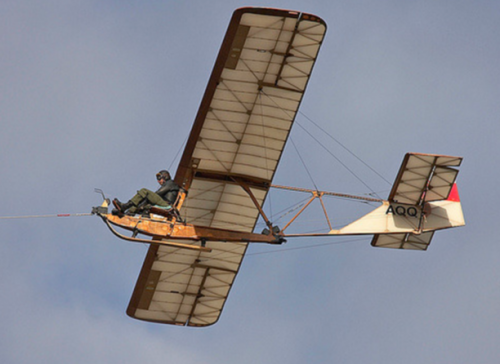
A Dagling glider in flight. This model has a wooden rear fuselage compared to the
metal tube structure on the Museum's example.
metal tube structure on the Museum's example.
Design and development
Primary training gliders evolved as very simple, even crude, airframes sufficiently basic and strong to withstand the rough handling of inexperienced beginner pilots. They had just enough flying ability (and vices) to give the trainee pilot the feel of the controls and enable him to grasp the basic skill of controlling an aircraft in flight.
During the 1920s Alexander Lippisch, a German aeronautical engineer, designed a training glider with very low performance to introduce pilots gradually to full-blown gliding. The result was a glider with a very simple structure of an open framework fuselage, with short wings attached by cables to a king post and the base of the fuselage. Lippisch's original design, the Zögling (pupil in English) had an all-wood fuselage, but Wolf Hirth instigated a redesign of the rear fuselage using steel tubes.
History
The plans for the modified Zögling made their way via the United States to the London Gliding Club and Reginald Foster Dagnall, whose RFD company put it into production as the RFD Primary. They built 27 in 1930-31. The type became known as the Dagling, a name formed by combining Dagnall and Zögling, which later became used informally to cover all types of primary gliders in the UK.
The Scarborough Gliding Club, of Yorkshire, UK, bought a Dagling Primary from RFD Co and started flying hops, but very quickly it was broken and was taken to Fred Slingsby’s furniture workshop in Scarborough for repair – this was the beginning of Slingsby’s huge involvement in the history of British gliding. Fred Slingsby took over construction in 1934 and production continued up to the outbreak of World War II when private gliding was banned.
The Museum has an example of the Dagling that is awaiting restoration. The history of this aircraft is an interesting story in itself. The aircraft, registered CF-ZAX, was constructed by a group in Lethbridge, Alberta calling itself the “Lethbridge Soaring Club” in the summer of 1947. The Club flew it briefly before disbanding in 1949. This was followed by flights in Medicine Hat, Red Deer and Edmonton. By 1953 the glider had been restored and was in Calgary to be used for flight training with Air Cadets. This program was short lived and the glider was moved to Innisfail where, in 1963, it was damaged in a storm and put in storage. The machine was next moved to Williams Lake, BC in 1973 with a proposal to start Air Cadet training. It was donated to the Museum in 1977, and was restored to display condition in 1983. It has remained in storage since then due to space requirements.
Technical Details
Crew: One
Empty weight: 180 lb (82 kg)
Loaded weight: 380 lb (173 kg)
Span: 34 ft 4 in (10.35 m)
Length: 17 ft 10 in (5.447 m)
Wing area: 162 ft2 (15.06 m2)
Aspect ratio: 11.1
Wing profile: Göttingen 326